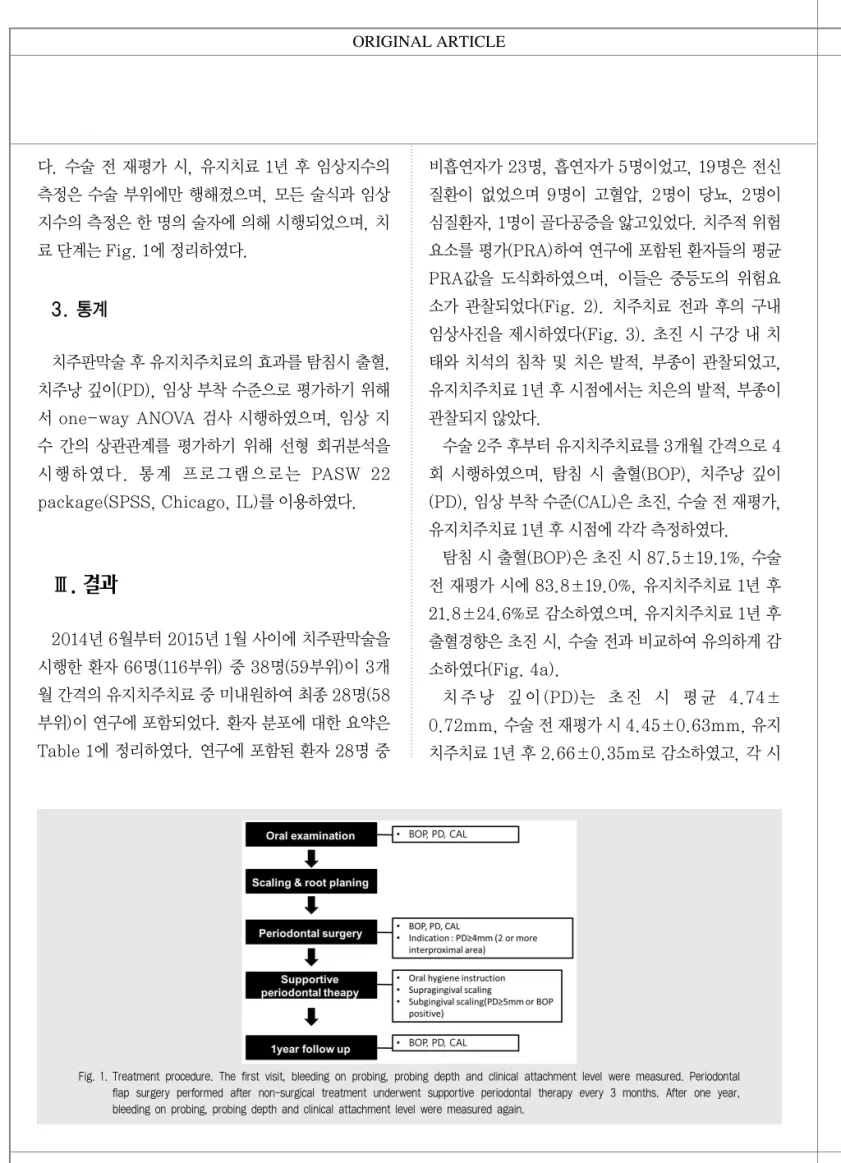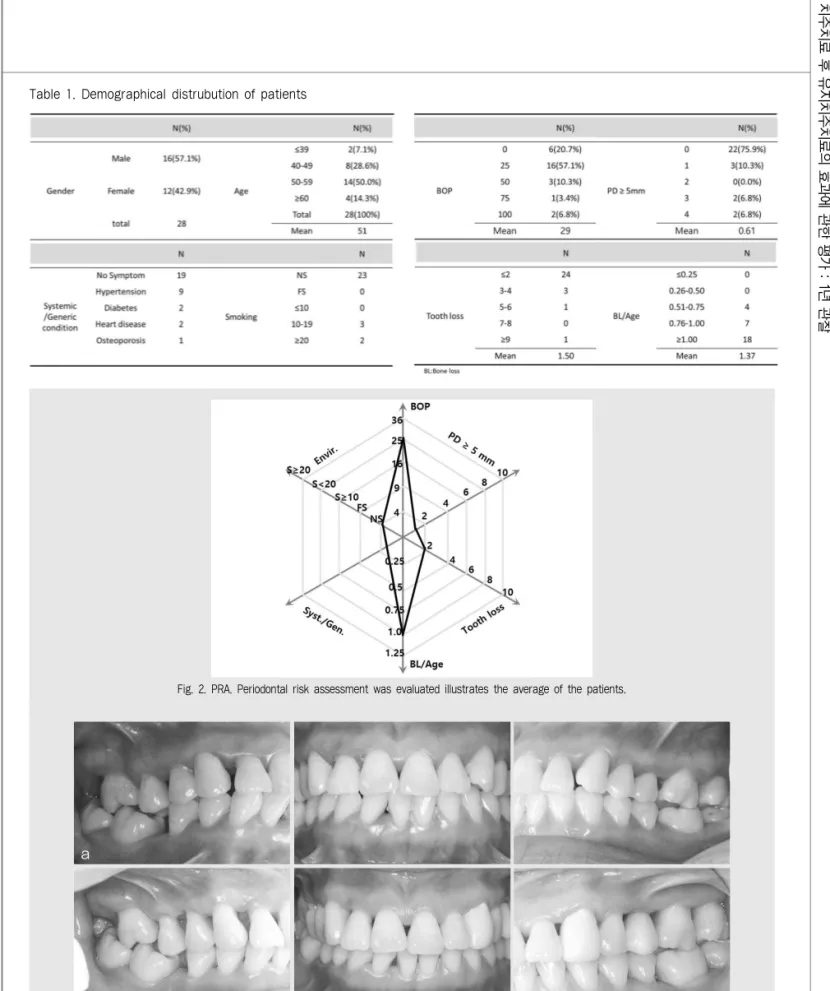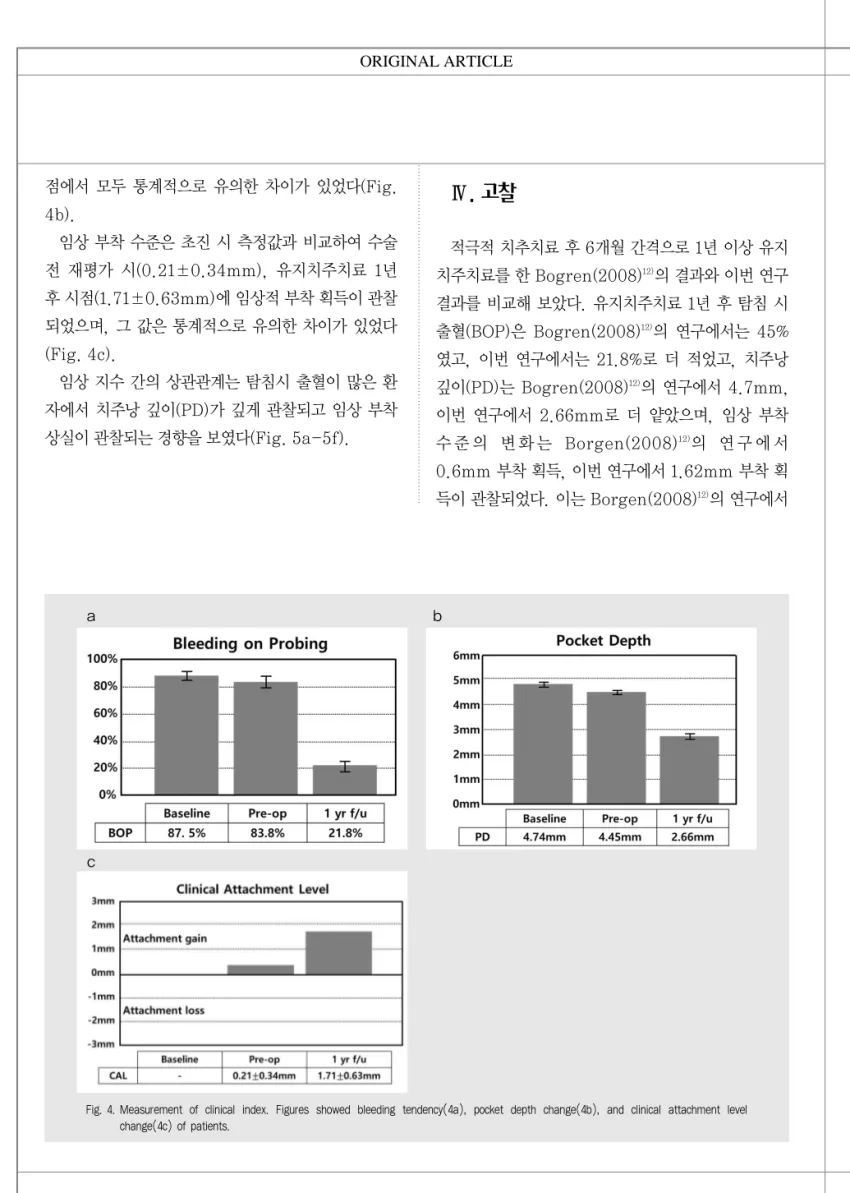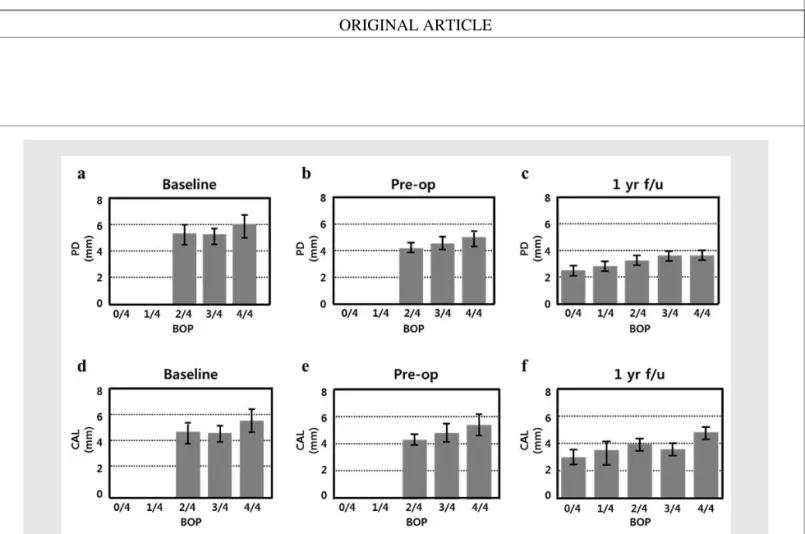1
경북대학교 치의학전문대학원 치주과학교실 김 신 영, 김 용 건
치주치료 후 유지치주치료의 효과에 관한 평가 : 1년 관찰
The effect of supportive periodontal therapy after periodontal treatment : A 1-year follow up.
Department of Periodontology, School of Dentistry, Kyungpook National University Shin-Young Kim, Yong-Gun Kim
Purpose : Preservation of the periodontal health of the treated patient requires supportive periodontal therapy for the elimination of periodontal disease. After Phase I therapy is completed, patients are placed on a schedule of periodic recall visits for maintenance care to prevent recurrence of the disease. The amount of tooth loss would be the most relevant criterion in an evaluation of the effect of periodontal treatment, but this would require studies with extremely long follow-up periods. Thus the most commonly used outcome criteria in clinical research have been clinical attachment level change, reduction of pocket depth and bleeding frequency. The purpose of this case study is to identify the effect of supportive periodontal therapy after periodontal flap surgery.
Materials & Methods : Following routine hygienic phase of treatment, patients with chronic periodontitis received surgical periodontal treatment. Bleeding on probing, pocket depth and clinical attachment level were measured at baseline, pre-operation and 1 year follow up. All procedures were performed by one operator.
Results : One year a total of 28 patients (58sites) to recheck remained, when conducted maintenance program after periodontal flap surgery was observed reduction of bleeding frequency, pocket depth and improvement of clinical attachment level.
Conclusion : The results from this study indicate that supportive periodontal therapy after periodontal flap surgery is effective for reduction of bleeding frequency, pocket depth and gain of clinical attachment level.
Key words : supportive periodontal therapy, pocket depth, bleeding on probing, clinical attachment level ABSTRACT
Corresponding Author 김용건
경북대학교 치의학전문대학원 치주과학교실, periokyg@knu.ac.kr
효과에관한평가: 1년관찰
Ⅰ. 서론
치주치료 후 행해지는 유지치주치료는 치주치료의 성공적인 결과를 위해서 꼭 필요하다1, 2). 유지치주치 료는 1단계 치주치료 완료 후 시작되며, 재평가를 통 해 2단계 외과적 치료나 3단계 수복치료를 거치게 된다.
여러 문헌에서 유지치주치료를 정기적으로 받은 환 자가 그렇지 않은 환자에 비해 장기적으로 예후가 좋 으며, 치아 상실률은 감소한다는 결과가 보고되었다
3~5). Nyman(1977)6)은 치주수술 후 유지관리를 하지 않은 환자를 2년간 관찰하였는데, 치주낭 깊이 (pocket depth, PD)가 거의 치료 전 수준으로 돌아 감을 보고하였다. Rosling(1976)7)은 치주수술 후 반 복적인 구강위생 교육과 매 2주마다 전문적인 관리를 하여 2년간 관찰한 결과, 치주낭 깊이(PD) 및 임상 부 착 수준(clinical attachment level, CAL)의 획득 이 양호함을 보고하였다.
이에 더해서 2003년 Lang과 Tonetti8)는 유지치 주치료의 진행에 있어 환자의 치주적 위험 요소를 평 가(periodontal risk assessment, PRA)하는 방 법을 제안하였다. 이 방법은 탐침 시 출혈(bleeding on probing, BOP), 5mm 이상의 치주낭 깊이 (PD), 잔존 치아수, 치주 지지의 상실, 전신 질환, 흡 연 상태를 포함한 6가지 인자를 기준으로 한다. 환자 의 치주적 위험 요소 평가(PRA)는 치주질환 진행의 감수성을 평가 할 수 있으며, 유지치주치료의 간격을 결정하는데 유용하다. 유지치주치료의 간격에 대해 Darcey 등9)은 치은 연하 미생물이 9-11주 내에 술 전 상태로 돌아갈 수 있다고 하였고, Ramfjord등10) 은 유지 치료 간격은 적어도 1년에 4회의 치료를 받는 것이 질환의 진전을 막을 수 있다고 하였다.
이에 본 연구의 목적은 만성치주염 환자에게 외과적 단계를 포함한 치주치료 후 3개월 간격으로 유지치주 치료를 진행하여 1년 후 탐침 시 출혈(BOP), 치주낭
깊이(PD), 임상 부착 수준(CAL)의 개선에 대한 효과 를 평가하는 것이다.
Ⅱ. 재료 및 방법 1. 연구대상
이 연구는 경북대학교 치과병원 치주과에 2014년 6 월부터 2015년 1월 사이에 내원하여 적극적인 치주치 료 후 유지치주치료를 받은 환자를 대상으로 하였다.
전반적 만성 치주염으로 진단되고, 초진 시 적어도 20 개의 잔존치가 있으며 전악에 걸친 비외과적 치주치료 후 구치부에 치주판막술을 받은 환자 중 1년 간 유지 치주치료에 참석한 환자를 포함하였다. 3개월 간격의 유지치주치료에 내원하지 않았거나 의무기록이 정확 하지 않은 환자는 제외하였다.
2. 연구방법
본 연구는 보건복지부 지정 공용기관생명윤리위원회 의 승인을 받아 진행하였다(P01-201608-21-005).
진료기록부를 이용하여 환자의 성별, 연령, 전신질환, 흡연 여부 및 임상 지수에 관한 자료를 수집하였다.
환자들은 초진 시 방사선사진을 촬영하고, 탐침 시 출혈(BOP), 치주낭 깊이(PD), 임상 부착 수준(CAL) 을 측정한 후 치석제거술과 치근활택술을 포함한 비외 과적 치주치료를 시행하였다. 그 후 재평가 시 소구치 와 대구치를 대상으로 탐침시 출혈이 있고 2개 이상의 인접부위에서 치주낭 깊이(PD)가 4mm이상인 경우 에 치주판막술을 시행하였다11). 치주치료 완료 후 2주 후부터 3개월 간격으로 4회 유지치주치료를 시행하였 으며, 내원 시 마다 구강위생교육, 치은연상 치석제거 를 하였고, 치주낭 깊이(PD)가 5mm이상이거나 탐 침시 출혈이 있는 부위에는 치은연하 치석제거를 하였
다. 수술 전 재평가 시, 유지치료 1년 후 임상지수의 측정은 수술 부위에만 행해졌으며, 모든 술식과 임상 지수의 측정은 한 명의 술자에 의해 시행되었으며, 치 료 단계는 Fig. 1에 정리하였다.
3. 통계
치주판막술 후 유지치주치료의 효과를 탐침시 출혈, 치주낭 깊이(PD), 임상 부착 수준으로 평가하기 위해 서 one-way ANOVA 검사 시행하였으며, 임상 지 수 간의 상관관계를 평가하기 위해 선형 회귀분석을 시행하였다. 통계 프로그램으로는 PASW 22 package(SPSS, Chicago, IL)를 이용하였다.
Ⅲ. 결과
2014년 6월부터 2015년 1월 사이에 치주판막술을 시행한 환자 66명(116부위) 중 38명(59부위)이 3개 월 간격의 유지치주치료 중 미내원하여 최종 28명(58 부위)이 연구에 포함되었다. 환자 분포에 대한 요약은 Table 1에 정리하였다. 연구에 포함된 환자 28명 중
비흡연자가 23명, 흡연자가 5명이었고, 19명은 전신 질환이 없었으며 9명이 고혈압, 2명이 당뇨, 2명이 심질환자, 1명이 골다공증을 앓고있었다. 치주적 위험 요소를 평가(PRA)하여 연구에 포함된 환자들의 평균 PRA값을 도식화하였으며, 이들은 중등도의 위험요 소가 관찰되었다(Fig. 2). 치주치료 전과 후의 구내 임상사진을 제시하였다(Fig. 3). 초진 시 구강 내 치 태와 치석의 침착 및 치은 발적, 부종이 관찰되었고, 유지치주치료 1년 후 시점에서는 치은의 발적, 부종이 관찰되지 않았다.
수술 2주 후부터 유지치주치료를 3개월 간격으로 4 회 시행하였으며, 탐침 시 출혈(BOP), 치주낭 깊이 (PD), 임상 부착 수준(CAL)은 초진, 수술 전 재평가, 유지치주치료 1년 후 시점에 각각 측정하였다.
탐침 시 출혈(BOP)은 초진 시 87.5±19.1%, 수술 전 재평가 시에 83.8±19.0%, 유지치주치료 1년 후 21.8±24.6%로 감소하였으며, 유지치주치료 1년 후 출혈경향은 초진 시, 수술 전과 비교하여 유의하게 감 소하였다(Fig. 4a).
치 주 낭 깊 이 (PD)는 초 진 시 평 균 4.74±
0.72mm, 수술 전 재평가 시 4.45±0.63mm, 유지 치주치료 1년 후 2.66±0.35m로 감소하였고, 각 시
Fig. 1. Treatment procedure. The first visit, bleeding on probing, probing depth and clinical attachment level were measured. Periodontal flap surgery performed after non-surgical treatment underwent supportive periodontal therapy every 3 months. After one year, bleeding on probing, probing depth and clinical attachment level were measured again.
효과에관한평가: 1년관찰
Fig. 2. PRA. Periodontal risk assessment was evaluated illustrates the average of the patients.
Fig. 3. Pre- and Post-treatment intraoral photos. The first visit, patients were observed in plaque and tartar deposits, gingival redness, swelling(3a). After one year follow-up gingival redness and swelling were disappeared(3b).
Table 1. Demographical distrubution of patients
a
b
점에서 모두 통계적으로 유의한 차이가 있었다(Fig.
4b).
임상 부착 수준은 초진 시 측정값과 비교하여 수술 전 재평가 시(0.21±0.34mm), 유지치주치료 1년 후 시점(1.71±0.63mm)에 임상적 부착 획득이 관찰 되었으며, 그 값은 통계적으로 유의한 차이가 있었다 (Fig. 4c).
임상 지수 간의 상관관계는 탐침시 출혈이 많은 환 자에서 치주낭 깊이(PD)가 깊게 관찰되고 임상 부착 상실이 관찰되는 경향을 보였다(Fig. 5a-5f).
Ⅳ. 고찰
적극적 치추치료 후 6개월 간격으로 1년 이상 유지 치주치료를 한 Bogren(2008)12)의 결과와 이번 연구 결과를 비교해 보았다. 유지치주치료 1년 후 탐침 시 출혈(BOP)은 Bogren(2008)12)의 연구에서는 45%
였고, 이번 연구에서는 21.8%로 더 적었고, 치주낭 깊이(PD)는 Bogren(2008)12)의 연구에서 4.7mm, 이번 연구에서 2.66mm로 더 얕았으며, 임상 부착 수 준 의 변 화 는 Borgen(2008)12)의 연 구 에 서 0.6mm 부착 획득, 이번 연구에서 1.62mm 부착 획 득이 관찰되었다. 이는 Borgen(2008)12)의 연구에서
Fig. 4. Measurement of clinical index. Figures showed bleeding tendency(4a), pocket depth change(4b), and clinical attachment level change(4c) of patients.
a
c
b
효과에관한평가: 1년관찰
는 유지치주치료를 6개월 간격으로 시행하였기 때문 에 이러한 차이가 나타난 것으로 볼 수 있다. 이번 연 구에 참여한 환자를 치주 위험 요소 평가한 결과 중등 도의 위험요소를 가지고 있었으며, 이 경우 6개월 간 격의 유지치주치료보다 3개월 간격의 유지 치추지료 시 임상 지수의 개선이 나타남을 확인할 수 있었다.
탐침 시 출혈(BOP)의 빈도가 높은 부위에서 치주낭 깊이(PD)가 깊게 관찰되며, 또한 부착 상실이 크다는 것이 이번 연구를 통해 확인되었다. 이는 적극적 치주 치료 후 유지치주치료 기간 중 출혈 횟수와 2mm이상 의 부착 상실의 사이를 관찰한 Lang 등13)의 연구 결 과와 같은 의견이다. Lang 등13)은 앞으로 발생될 부 착 상실의 30%가 탐침 시 반복적으로 출혈이 나타나 는 부분에서 예상된다고 하였다. 따라서 유지치주치 료 기간에 반복적인 출혈은 부착 상실의 위험이 높은 부위로 볼 수 있다.
이번 연구 결과에서 만성 치주염의 적극적인 치주
치료 후 3개월 간격으로 유지치주치료에 참여한 환자 는 1년 간 42.4%(28명)였다. 이는 Demetriou 등14) 의 연구(27.4%)에 비해 높은 것이다. 따라서 환자의 협조도는 유지치주치료의 성공에 있어 중요한 요소이 다. 정기적인 치주치료를 받은 환자들이 그렇지 않은 환자들보다 좋은 예후를 보인다는 것이 명확하므로, 협조하지 않거나 협조도가 낮은 환자들은 치주질환의 진행에 대해 위험요소가 더 높은 것으로 간주할 수 있 다. 여러 연구에서 협조도가 좋은 환자가 낮은 치태지 수를 보였고, 이 치태지수는 환자의 구강 위생 관리 능력을 반영한다15~18). 또한 협조도가 좋은 환자는 비 협조적인 환자에 비해 구강위생의 중요성을 잘 알고 있다19). Mendoza 등20)은 협조도가 감소하는 이유를 조사한 결과, 비순응의 이유 중 가장 높은 비율을 나 타낸 항목은“개인치과에서 정기적 치료를 받고 있 음”, 그 다음은“비싼 비용”, “치료의 필요성을 느끼 지 못함”등 이었다. 이러한 점을 고려하여 만성 치주
Fig. 5. Correlation between clinical index. The higher the bleeding tendency is observed in the deep periodontal pockets(5a,5b,5c), the greater the value of clinical attachment level(5d,5e,5f).
염 환자에서 적극적 치주치료 후 건강한 치주 상태를 유지하기 위해 임상가는 환자에게 유지치주치료에 대 한 필요성을 더욱 강조해야 하며, 환자도 유지치주치 료의 중요성을 이해하여 협조도를 높일 필요가 있다 고 생각한다.
본 연구에서 만성치주염 환자에게 시행한 외과적 단 계를 포함한 치주치료 후 3개월 간격의 유지치주치료
는 탐침 시 출혈(BOP)의 감소, 치주낭 깊이(PD)의 감소, 임상 부착 획득을 얻는데 효과적이다. 또한 이 번 연구에서는 초진, 수술 전 재평가, 유지치료 1년 후 시점에 임상지수를 측정하였는데, 이것으로 수술에 대한 효과가 유지치료에 의해 유지되었음을 확인할 수 있었다.
효과에관한평가: 1년관찰 1. Axelsson P, Lindhe J. The significance of
maintenance care in the treatment of periodontal disease, J Clin Periodontol 1981;8:281-294.
2. Shick RA. Maintenance phase of periodontal therapy, J Periodontol 1981;52:576-583.
3. Kim SY, Lee JK, Chang BS, Um HS. Effect of supportive periodontal therapy on the prevention of tooth loss in Korean adults, J Periodontal Implant Sci 2014;44:65-70.
4. Ramfjord SP. Maintenance care for treated periodontitis patients, J Clin Periodontol 1987;14:433- 437.
5. Wilson TG, Jr., Glover ME, Malik AK et al. Tooth loss in maintenance patients in a private periodontal practice, J Periodontol 1987;58:231-235.
6. Nyman S, Lindhe J, Rosling B. Periodontal surgery in plaque-infected dentitions, J Clin Periodontol 1977;4:240-249.
7. Rosling B, Nyman S, Lindhe J, Jern B. The healing potential of the periodontal tissues following different techniques of periodontal surgery in plaque-free dentitions. A 2-year clinical study, J Clin Periodontol 1976;3:233-250.
8. Lang NP, Tonetti MS. Periodontal risk assessment (PRA) for patients in supportive periodontal therapy (SPT), Oral Health Prev Dent 2003;1:7-16.
9. Darcey J, Ashley M. See you in three months! The rationale for the three monthly periodontal recall interval: a risk based approach, Br Dent J 2011;211:379-385.
10. Ramfjord SP. Maintenance care and supportive periodontal therapy, Quintessence Int 1993;24:465- 471.
11. Eke PI, Page RC, Wei L et al. Update of the case definitions for population-based surveillance of periodontitis, J Periodontol 2012;83:1449-1454.
12. Bogren A, Teles RP, Torresyap G et al. Locally delivered doxycycline during supportive periodontal therapy: a 3-year study, J Periodontol 2008;79:827-835.
13. Lang NP, Joss A, Orsanic T et al. Bleeding on probing. A predictor for the progression of periodontal disease?, J Clin Periodontol 1986;13:590-596.
14. Demetriou N, Tsami-Pandi A, Parashis A.
Compliance with supportive periodontal treatment in private periodontal practice. A 14-year retrospective study, J Periodontol 1995;66:145-149.
15. Konig J, Plagmann HC, Langenfeld N, Kocher T.
Retrospective comparison of clinical variables between compliant and non-compliant patients, J Clin Periodontol 2001;28:227-232.
16. Checchi L, Montevecchi M, Gatto MR, Trombelli L.
Retrospective study of tooth loss in 92 treated periodontal patients, J Clin Periodontol 2002;29:651- 656.
17. Miyamoto T, Kumagai T, Jones JA et al.
Compliance as a prognostic indicator: retrospective study of 505 patients treated and maintained for 15 years, J Periodontol 2006;77:223-232.
18. Costa FO, Lages EJ, Cota LO et al. Tooth loss in individuals under periodontal maintenance therapy:
5-year prospective study, J Periodontal Res 2014;49:121-128.
19. Woong-Kyu Park, Jae-Kwan Lee, Beom-Seok Chang, Heung-Sik Um. A retrospective study on patients’ compliance with supportive periodontal therapy, J Korean Acad Periodontol 2009:59-70.
20. Mendoza AR, Newcomb GM, Nixon KC. Compliance with supportive periodontal therapy, J Periodontol 1991;62:731-736.
참 고 문 헌



